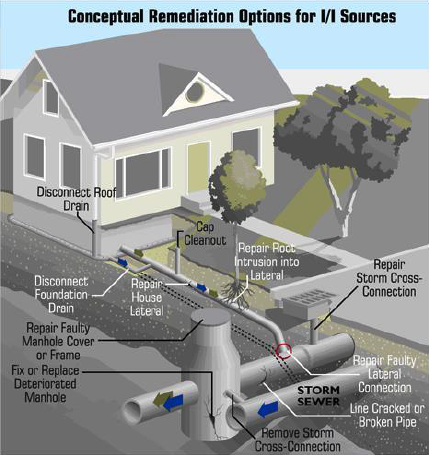 The Town of newmarket and Civica Infrastructure Inc. are working together on an Inflow and Infiltration reduction study. The purpose is to identify and reduce the sources of I/I entering the sanitary sewers and to develop a plan to reduce these 'extraneous flows'. A flow monitoring the program will identify areas within the town of Newmarket that have high I/I. The field testing includes fog and dye testing and CCTV inspection
The Town of newmarket and Civica Infrastructure Inc. are working together on an Inflow and Infiltration reduction study. The purpose is to identify and reduce the sources of I/I entering the sanitary sewers and to develop a plan to reduce these 'extraneous flows'. A flow monitoring the program will identify areas within the town of Newmarket that have high I/I. The field testing includes fog and dye testing and CCTV inspection
What is fog testing?
The fog testing consists of blowing a harmless coloured fog into manholes and
pipes and observing where the fog exits from the system. The fog is expected
to exit primarily out of manholes on the street and plumbing ventilation stacks
at the top of buildings. It is also possible for fog to exit stormwater catch basins
and roof downspouts at the side of a house, where inappropriate
connections were made to the sanitary sewer.
The fog used in the test has no odour and is not harmful to your health, and will
disappear after a few minutes.
Notices will be distributed to residents in areas where fog testing will be
occurring. On the day of testing, Civica Infrastructure staff will visit each
building to notify them that testing will be occurring. Please note that there
is no need to be home during testing and that there is no need to enter the
building to conduct the test. Civica Infrastructure staff, identified with a
company name tag, will be on site during the entire process of the testing.
What you need to do prior to Scheduled Fog Testing?
Pour one (1) pail of water into any infrequently used sink and in your basement
floor drain on receipt of a fog testing notice (refer to the notice in your mail or
to the Fog Testing Status on this website for testing dates).
Call Civica Infrastructure at 905-417-9792, if you have a health condition you think may be affected by the testing.
What is dye testing and why is it conducted?
Dye testing is a method used to locate rain or groundwater entry points into the
sanitary sewer system. During this process, non-toxic, biodegradable dyed water is
introduced into roof leaders, driveway drains, or catch basins. After introducing the
dyed water, the downstream sanitary sewer manhole is checked. Dye testing with a
non-toxic, biodegradable dye is one way of determining where a pipe or structure
drains to if it is not obvious by observation or on existing plans or records. By
conducting dye testing, inappropriate connections can be identified. For instance, if a
dye is introduced to a catch basin and the dye is then observed in the sanitary
sewer downstream from that point, this would indicate that the catch basin is directly
connected to the sanitary sewersystem.
Dye testing is used to identify direct sources of I/I. The process consists of pouring
harmless dye/water mixture into potential illegal connections. These connections
form part of the storm sewer system and can consist of roof drain leaders, driveway
drains, manholes, catch basins, etc. After introducing the dyed water, the downstream sanitary sewer manhole is checked for dyed mixture. By conducting dye
testing, inappropriate connections from the storm to the sanitary systems can be
identified.
How safe is the dye used?
The dye is non-toxic, biodegradable and poses no harmful effects to humans, wildlife
or the environment. The dye does not permanently stain and washes away with water.
The dye is fluorescent GREEN in color. The dyed water is poured directly into the
sanitary system or roof drain leaders; therefore it is unlikely that any person will come
into contact with the dye. Signs will be displayed along outfalls of the storm sewer
system such as rivers and creeks. Do not be alarmed if you observe a GREEN liquid
entering a waterway in your area or if your waterway is GREEN during testing
periods.
What do I need to know?
The resident of each property will be informed 1 week before testing by notice,
door hanger notice and on the day of testing by a Civica Infrastructure representative
with an ID badge. On the day of testing, our field crews will require access to the
exterior of your property i.e. roof leaders, area drains but will NOT require access into
your home. There are no other measures needed to be taken by the resident before
dye testing.
Who can I contact if I have further questions?
Tejiri Nikoro, Project Coordinator, Civica Infrastructure, 905-417-9792 ext. 2336, [email protected]
Nirujaan Kanagendran, Project Coordinator, Civica Infrastructure, 905-417-9792 ext. 2303, [email protected] (Main Contact)